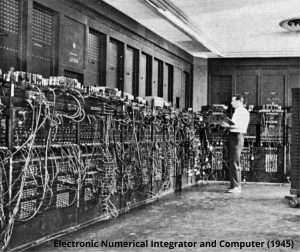Artificial Intelligence for Facility Management
Posted on February 27th, 2022 Facility managers and property owners are constantly looking for ways to reduce costs and save energy. Artificial Intelligence (AI) is touted as a super solution for many issues. So, is AI ready to reduce costs and energy consumption in your facility? Let’s look at exactly what AI is and whether or not you need it.
Facility managers and property owners are constantly looking for ways to reduce costs and save energy. Artificial Intelligence (AI) is touted as a super solution for many issues. So, is AI ready to reduce costs and energy consumption in your facility? Let’s look at exactly what AI is and whether or not you need it.
The Marvel of Computing Power
The notion that machines would someday be able to replicate human intelligence took a large step forward in 1945 with the development of the first general purpose digital computer, ENIAC, the Electronic Numerical Integrator and Computer. Built at the University of Pennsylvania, ENIAC was some 8 feet high, 3 feet deep, 80 feet long, contained 17,468 vacuum tubes and weighed 30 tons. As unwieldy and failure prone as it was, ENIAC was ideal for its original purpose: calculating the ballistic trajectories of artillery shells.
In the 75-plus years since ENIAC was capable of processing 500 FLOPS (Floating Point Operations per Second), computational power has increased according to the empirical Moore’s Law. That observational law has been reasonably accurate for almost 50 years in its prediction that the number of semiconductors contained on a single chip doubles every two years. In comparison to ENIAC, modern computers process quadrillions (10E15) FLOPS. With such amazing computational power, it seems intuitively obvious that artificial intelligence is on the horizon. Or is it?
Artificial Intelligence (AI)
Google AI researcher, Francois Chollet, described “intelligence” as a system’s ability to adapt to new environments, to generalize its knowledge and apply that knowledge to unfamiliar scenarios. He said, “Intelligence is not skill itself; it’s not what you can do; it’s how well and how efficiently you can learn new things.” Thus, AI is not the ability of a system to perform a task, but it is the ability of a system to act autonomously and optimally based on experience and the available data, or lack thereof.
For example, very young children can readily identify a cat in a picture of many objects after just a few experiences. On the other hand, it took years to develop the software and system that could perform the same task with a 60% to 85% success rate. Another example that AI might not be ready for prime time occurred just a few years ago: the media was incessantly talking about the inevitability and benefits of AI-enabled autonomous vehicles (AVs) or self-driving cars.
Today, the reality is that the Society of Automotive Engineers has defined six levels of driving automation from none (Level 0) to humans being unnecessary (Level 5). As of March 2022, however, the National Highway Traffic Safety Administration, advises that there are no commercially available vehicles that utilize automation beyond Level 2 where the driver is fully responsible for driving.
All of this is not to say that AI will never become a reality. It simply suggests that AI’s development is very likely to be slow and incremental and that someday AI will initially be applied to very specific and limited applications. It is also a caution about “AI-washing” which like green-washing is the creation of false or misleading impressions about a product. Facility managers might be wise to view anything that claims to be AI or AI-ready with a degree of skepticism.
Will Your Facility Need AI?
The description above suggests that artificial intelligence must accept never-before-seen types of variable data, analyze that data and then initiate an optimal signal or action. Consider what that means for the driverless vehicle. The AI not only has to keep the vehicle on the road, it has to:
- Adjust the vehicle’s travel due to signs, human and mechanical signals, obstacles, weather, other vehicles, etc.
- Identify objects in the road and on the roadside (children, mailboxes, trees, accidents, etc.),
- Calculate the likelihood of those objects moving into the vehicle’s path, and then
- In real time, decide upon the correct avoidance action to take.
In comparison, the efficient daily operations of buildings or facilities require far fewer variables and much less complex data and analysis. A facility’s mechanical system operates within known states and ranges such as being on or off and limits of temperatures, pressures and humidity, fluid and gas flows, amps and voltages, etc. The bottom line is that modern building and energy management systems can monitor hundreds or thousands of input signals and apply elaborate algorithms to optimize energy efficiency and costs, comfort, safety and maintenance throughout a facility, without the need for AI.
Optimize Facility Operations
Hopefully it is clear that there is no benefit to wait for AI or pay extra for “AI-ready” products to improve facility operation or manage costs. “HI” or human intelligence remains the best solution for that. Call Equans MEP Services to get the human intelligence, automation systems and experience you need to improve your facility’s operation.
